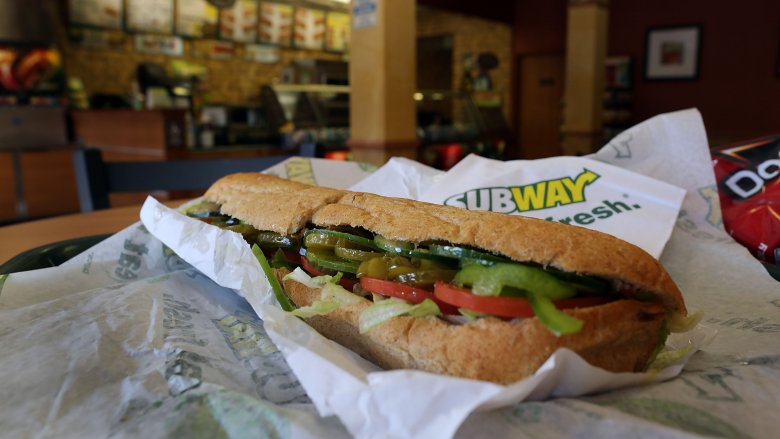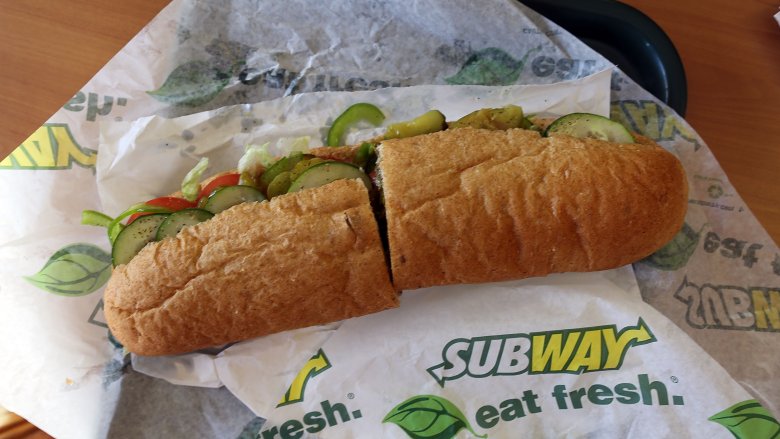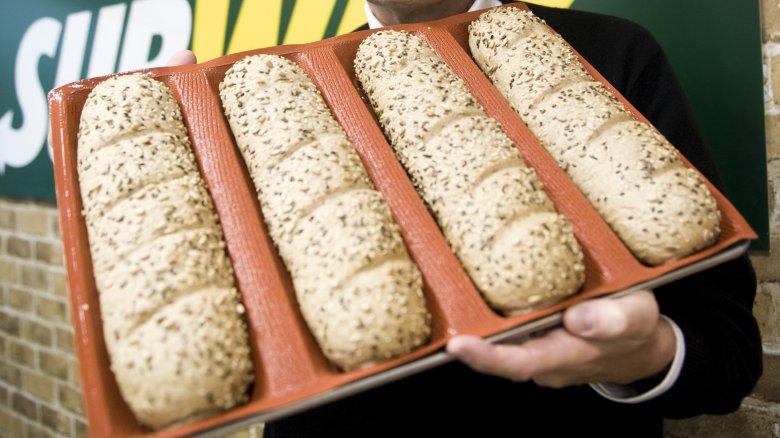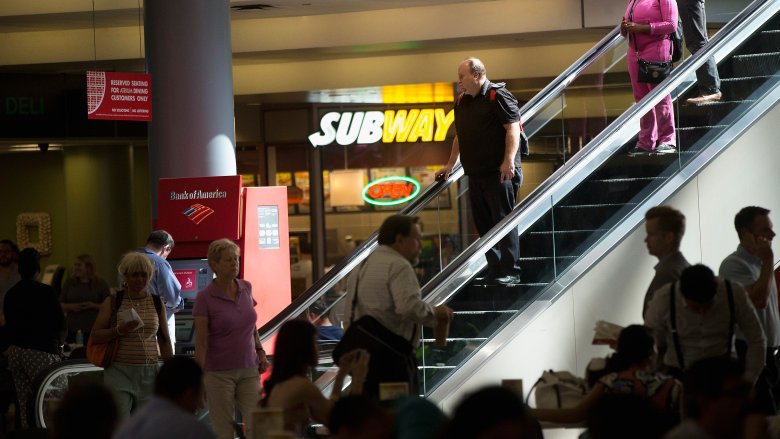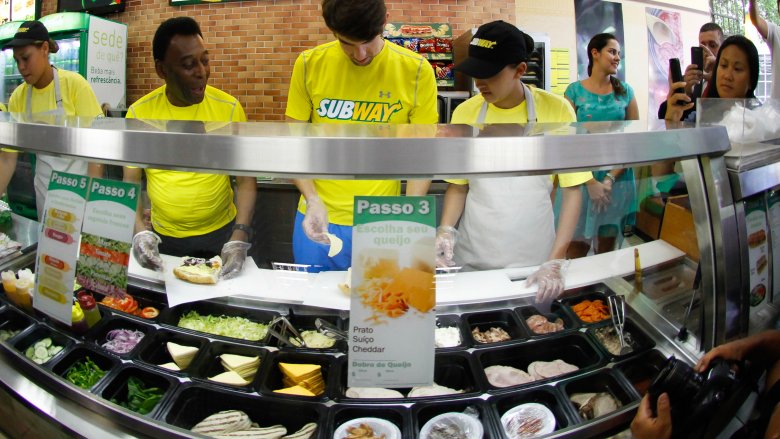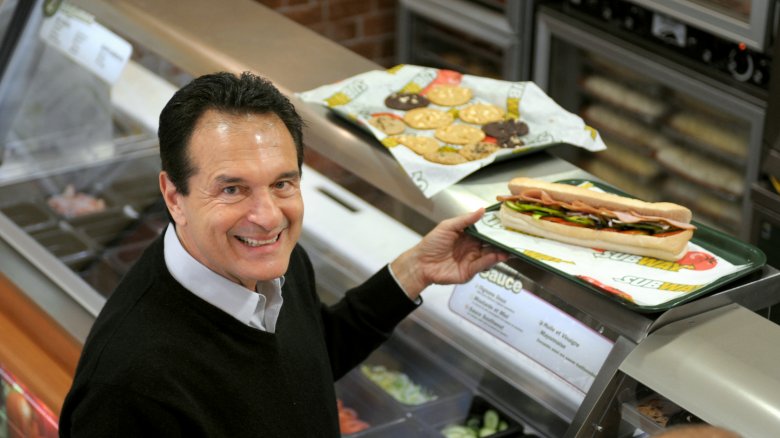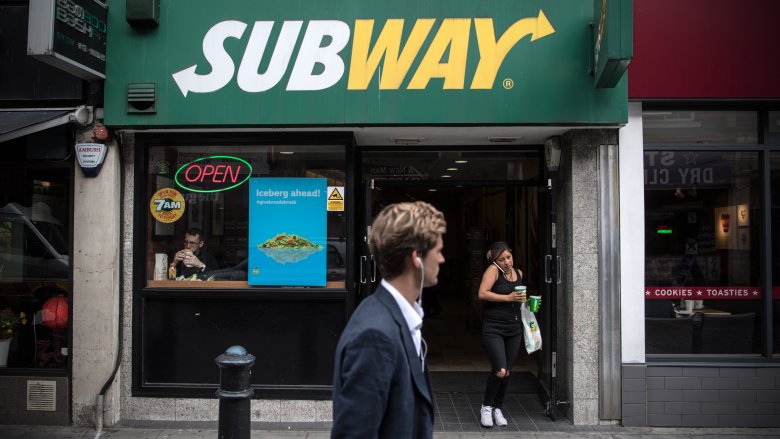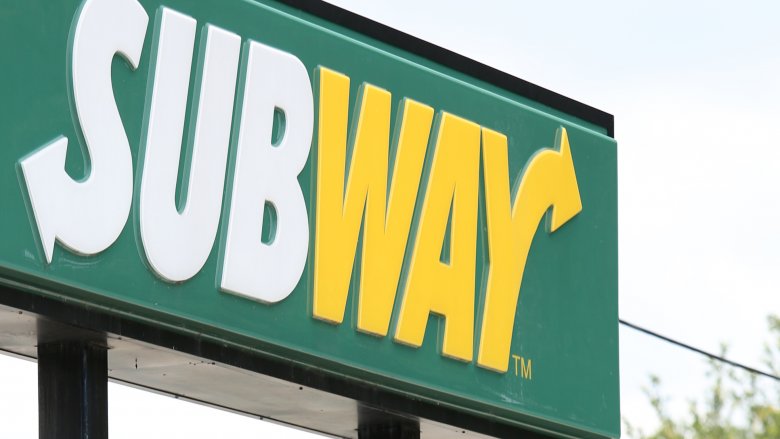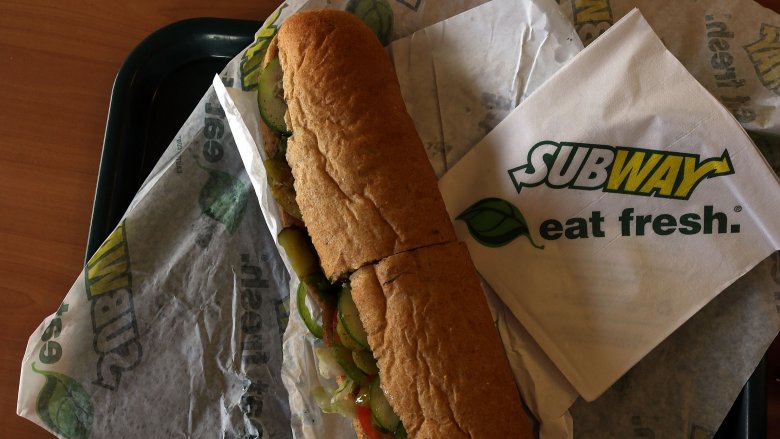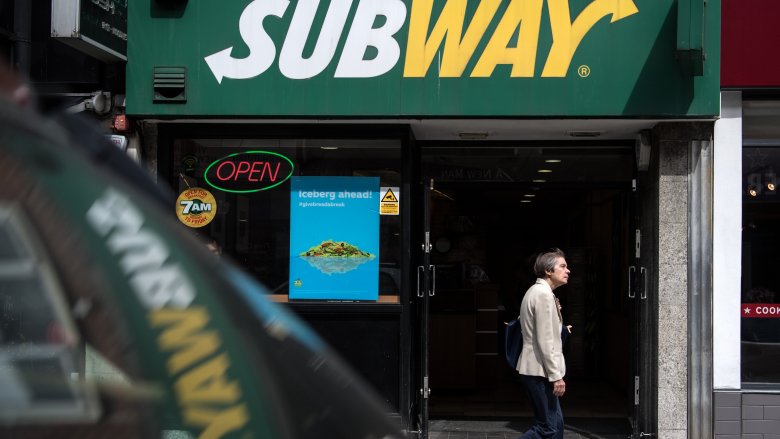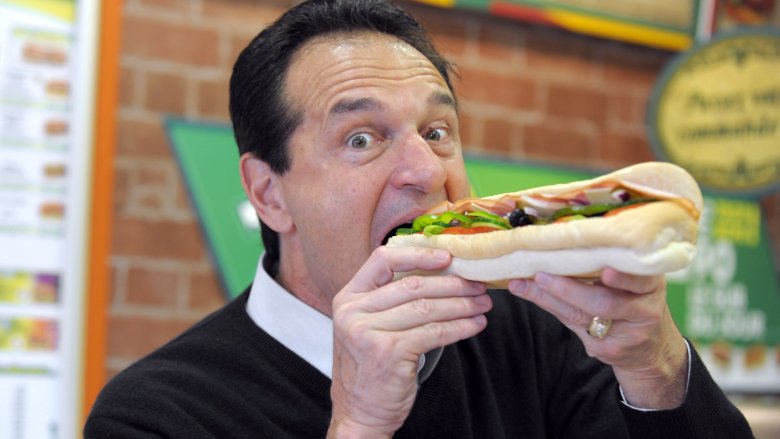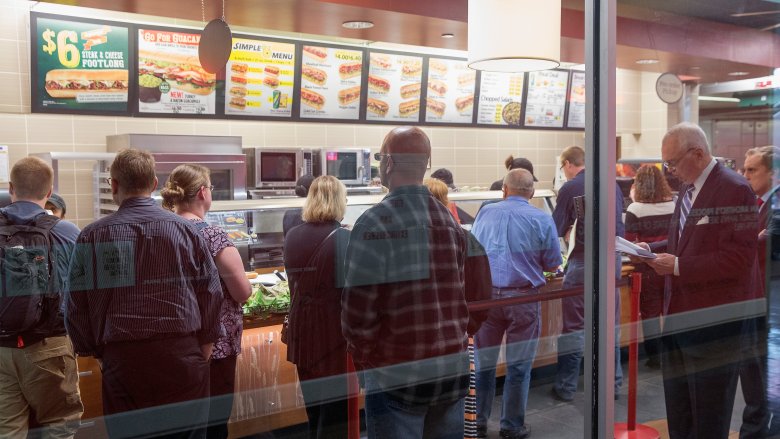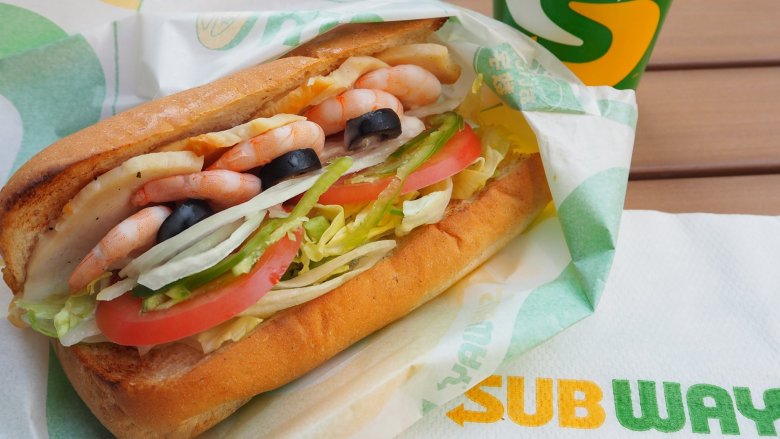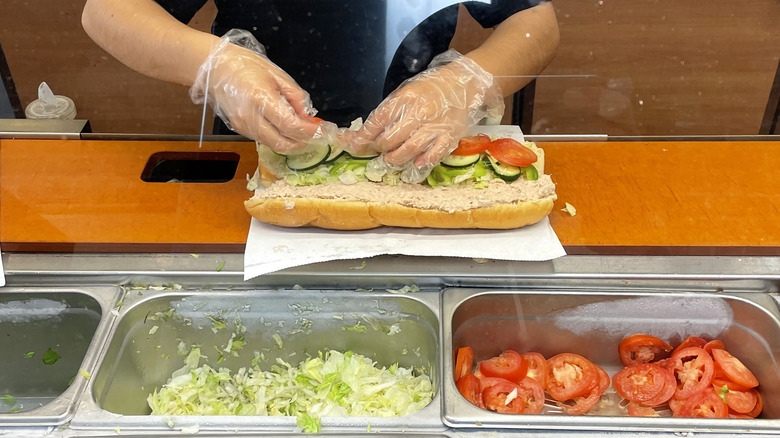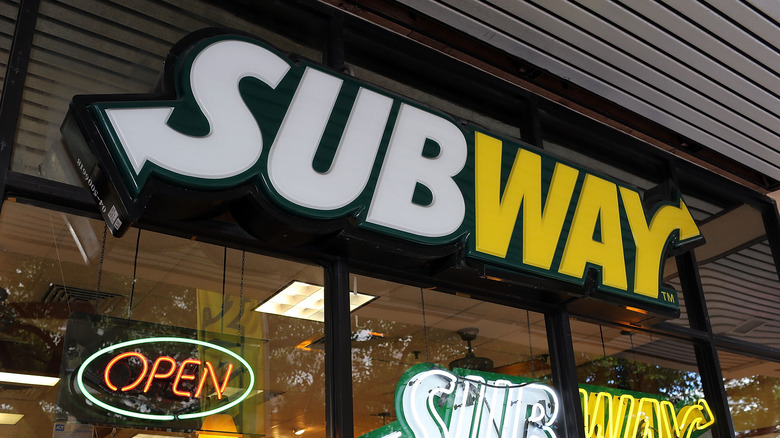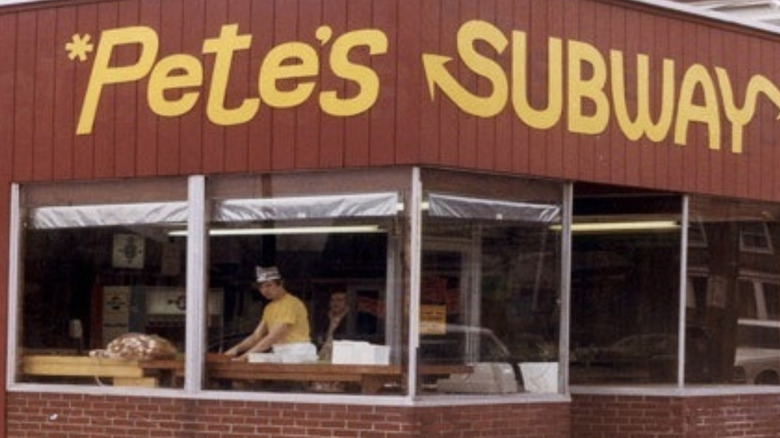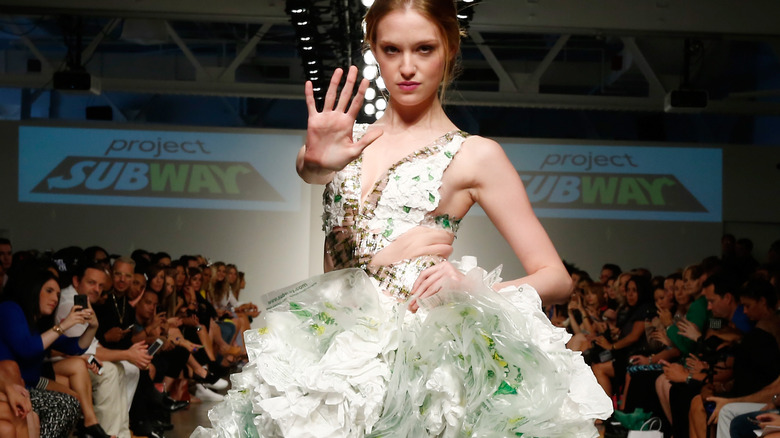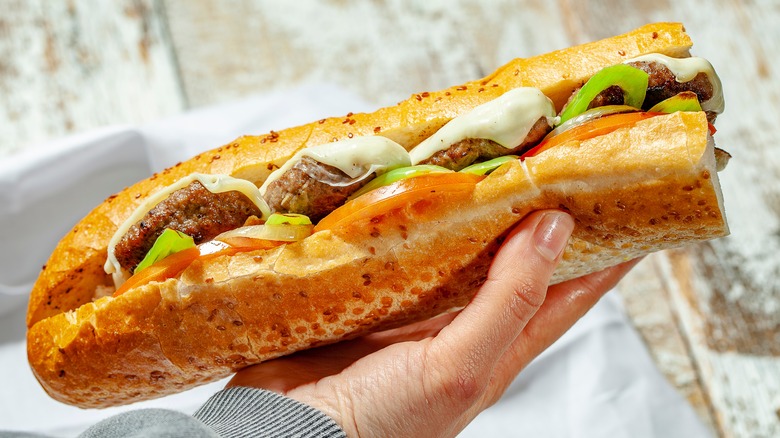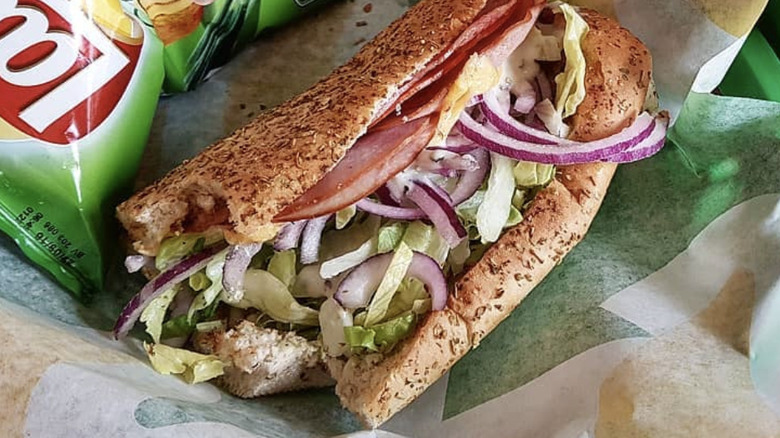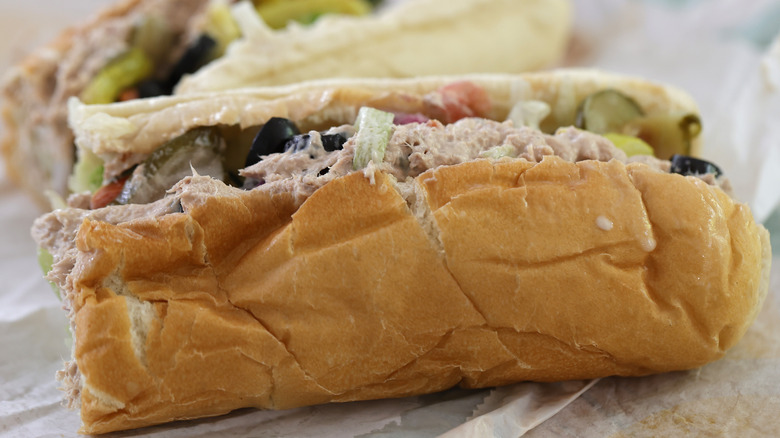The Untold Truth Of Subway
When Subway first opened, customers were seriously impressed with the freshness of its ingredients, the deliciousness of its subs, and the idea that a "sandwich artist" was going to make it right in front of you, and add whatever you asked them to. Soggy bread? Surprise tomatoes, even though you specifically requested no tomatoes? Not here!
So Subway grew and grew and grew. According to Statista, it hit its peak around 2016 with an almost unthinkable 44,702 restaurants worldwide. Even when locations started closing in 2017, CNBC reported that it was still the biggest fast food chain in the world. Yep, it beat even McDonald's — by 6,671 restaurant locations — and Starbucks — by a shocking 16,573 locations. But all was not well, and it was a case of the numbers definitely not telling the whole story. Subway was struggling.
What happened was complicated, and the whole story of Subway is complicated. It's had more than its fair share of scandals and bad news stories, and it's had its share of successes, too. What don't you know about the once-favorite sandwich chain that's become the last resort for many? A lot. This is the untold truth of Subway.
You don't know the whole story of Subway's too-short footlong
Subway has been associated with a lot of bad press, and one of the claims that took social media by storm was the one that said it was selling 12-inch subs that weren't actually 12 inches long. According to Reuters, the whole thing started in 2013 when one Australian teen posted a picture of his sub and proof that it was only 11 inches long. It went absolutely viral, and Subway went to court.
But then the weirdness happened.
According to Forbes, Subway agreed to settle for half a million dollars and to implement new policies that would regulate its bread-making process a little more. That's after the case was found to be pretty weak for a bunch of reasons, including the fact that most footlongs were, indeed, a foot long, they were all made from raw dough that weighed the same, and Subway's standardized way of putting on the toppings means customers weren't getting shorted any fillings. And, since not every Subway customer got a short sub, that meant a class action settlement didn't make sense.
So, what was going to happen was pretty outrageous: the lawyers involved were going to walk away with a cool $520,000, and the 10 plaintiffs were going to get $5,000 each.
Insane? A U.S. appeals court thought so, too, and threw out the settlement after calling it "utterly worthless."
Here's the truth of the yoga mat chemical at Subway
Remember the outrage over Subway's bread and the so-called "yoga mat chemical?" Of course you do, because social media went mad when it came out that one of the ingredients in Subway's bread was also found in yoga mats. The chemical in question is called azodicarbonamide, and according to CNN, it's usually included in products to help strengthen the dough.
There are two different sides to the story here. On one hand, it's been used for a long time and it's been deemed safe by the FDA. In fact, NPR found it was an ingredient in almost 500 different products, including everyone's childhood favorite, Wonder Bread. But it was Subway that was targeted the most, thanks to a post from self-declared expert the Food Babe.
Is there anything actually dangerous about it? Not in the amount deemed safe by the FDA, which is a mere 45 parts per million. Research done by the Center for Science in the Public Interest found that azodicarbonamide does break down into a few substances that do pose what they deemed "a small risk" to humans, and it is banned as a food additive in the EU and in Australia. Not long after the outrage, Subway announced it was going to remove it from its recipe.
How did Subway get so popular doing what so many others were doing?
So how did Subway make subs such a big deal, when so many other people were already making them?
According to Entrepreneur, there were a few things going for the company. It had something other chains didn't, and that's a story. It touted its freshness and healthiness, and more than just saying how healthy its food was, it kicked off a campaign around someone who lost a ton of weight thanks to its meals. And it was perfect timing, too, as it happened when more people were looking for healthy options that were still fast, and they jumped on the trend.
It was also one of the first restaurants to start making food right in front of the customer — and customers loved it. They knew exactly what was going on their sub, and they could add as they went along. That got them engaged and invested in their meal, and that's important.
It wasn't just Americans who were impressed with the affordability, freshness, and quick service. According to the BBC, customers in the UK found the very same things so awesome that Subway opened 2,500 stores there.
There was something else at work here, too, and it's probably something you never considered. Since Subway marketed itself as super healthy, it was able to get partnerships with places that less healthy fast food chains couldn't, like hospitals. And that was a whole untapped market.
How fresh is Subway, really?
Subway built its business on the idea that it was going to allow customers to "eat fresh," but by 2018, customers were pointing out that things weren't so fresh after all.
Business Insider says that 2017 was a bad year for the chain, and part of its fall from grace was ingredients that weren't so much "fresh" as they were "mushy and rotten." When Business Insider spoke to franchise owners and employees, they found most Subway locations only received deliveries of produce once or — at most — twice a week. Some owners even claimed that they had been willing to shoulder the extra costs of getting more frequent deliveries, but the requests were denied by corporate.
Think the lettuce on your last Subway sub was a little past prime? You're not alone: Those employees say lettuce was a huge problem, and was often turning by the time it got to the store. Subway responded, saying it went above and beyond to make sure it served only the freshest ingredients ... but didn't say how often they were delivered.
It gets worse. According to some owners, they have no choice in the matter. Some have attempted to switch to local produce suppliers only to have their franchise license revoked.
How healthy is Subway, really?
Subway has long pushed the idea that it's the healthier choice when it comes to grabbing a quick meal, but is it? Sort of.
Healthline took a close look at the brand's nutritional information, and they found that there are some good options there. The six inch black forest ham, roast beef, turkey breast, veggie delite, club, sweet onion chicken teriyaki, oven roasted chicken, and rotisserie style chicken all meet the American Heart Association's requirements for being a healthy meal, as long as you opt for the 9-grain wheat and toppings like green onions and tomatoes... and don't load up on sauces.
But they're not all great. Some, like the chicken Caesar melt and the chicken and bacon ranch melt, don't even sound healthy. But others are deceiving. Also on the unhealthy list? The classic tuna, even though it's easy to think that anything with tuna in it is going to be a decent choice, mayo-laden or not.
In 2016, Business Insider decided to give the infamous "Subway Diet" a go. By the second day, they declared it was impossible. The healthy subs just weren't filling, satisfying, or tasty, even calling it "food you eat in order to survive." That's not a glowing review, and let's be honest — eating healthy doesn't have to be bland or boring, so why make it be that way?
You're not imagining it, the Subway smell is a real thing
It's one of those things we all know about, but rarely mention: it's the Subway smell. You know exactly what we're talking about even if you've never consciously thought about it until this moment, don't you? And it's weird. It definitely smells like bread, but it doesn't smell like any other kind of bread in the world. What's the deal?
Food Republic was determined to find out, and they went right to the source: Mark Christiano, who has the title of Global Baking Technologist at Subway.
According to him, it's just freshly baking bread. He didn't give details as to recipe specifics, but he did say that it's basically yeast, water, sugar, and flour, and that there's nothing added to the bread or the process to get it to make that smell. Food Republic did uncover a few things that might possibly account for the uniqueness of the smell, including the fact that the dough has been frozen. It's also possible that part of what you're smelling is sugar that's caramelizing, but Christiano says, "There's nothing artificial in there that they're smelling." Mystery ... solved?
Your Subway isn't the only one to close
If your neighborhood Subway has closed in the last few years, you're definitely not alone. According to Bloomberg, the number of U.S. locations dropped by more than 2,300 between 2015 and 2018.
The reason why sales and the number of stores has continued to plummet is complicated. Among the chief factors are scandals like the not-so-long footlong rolls, bad publicity surrounding the not-so-fresh veggies, failed attempts at kicking off a loyalty plan that actually inspired loyalty, and an inability to compete with other sub shops that have opened in the years since Subway first opened its doors.
And while the brand already closed a ton of locations, Bloomberg crunched the numbers and found that closures are happening faster and faster as time goes on. They're not slowing down and business isn't turning around, and that suggests the future of Subway is still very much up in the air. The chain closed another 1,000-plus locations in 2021, according to The New York Post.
Subway helped rebuild at the World Trade Center
While it's true that Subway has closed a ton of locations in recent years, there was one location that was opened knowing it was going to be closed shortly — once a job was done.
Even as the building at 1 World Trade Center rose, so did a Subway restaurant. It was built by DCM Erectors, says The New York Times, and it — along with a set of offices, bathrooms, and changing rooms — was among a series of movable pods installed for the workers building what would become the city's tallest building. Until Subway, workers only had two options: bring their lunch, or head out to a restaurant. But that included a trip down to ground level, and that meant a 30-minute lunch break could turn into an hour, and most was spent waiting in line or on an elevator. No one wants that.
Enter Subway, this one owned by franchisee Richard Schragger — who gave out free cookies to all the workers on his first day there. Subway beat out nine other options for a restaurant at the site, and until it closed in 2012 (via Gothamist), Subway workers did their part helping those who were helping rebuild a huge part of New York City's history.
Their attempts at a kosher version of Subway failed
Visit any Subway across the country, and you'll find they're pretty standard. But Subway has tried something pretty unexpected, and in 2011, The Wall Street Journal took a look at some that were very, very different: they were kosher.
The company kicked off the program in 2006 and said the potential for a series of kosher restaurants was huge. At least a dozen opened, but as of 2011, only five were still around. (In 2017, Yeah That's Kosher reported only two remained open: one in Ohio and one in Florida.)
Kosher Subways ran into some big problems. Not only do kosher restaurants have to serve no pork and keep meat and dairy separate, but kosher meat prices can run double what non-kosher meat costs — and that raises the cost and the price of subs. With 12-inch subs starting at around $9, it means customers start weighing their options and just going to a normal deli.
Products can be hard to source, and then there are operational concerns, too. They have to close during the Sabbath, which is a prime time during the week — sunset on Friday to sunset on Saturday. The employee turning the ovens on needed to be an Orthodox Jew, and each location had to pay for random inspections by a rabbi. It was a great idea, but one that ultimately just wasn't practical from a business point of view.
Not everyone liked Subway's $5 footlong
Love the $5 footlong? It was a great deal, and you got a decent lunch for a decent price. But franchisees definitely didn't share your love of it.
The $5 footlong was around for a long time before it was replaced by the $6 footlong in 2016. According to Money, it was about as popular as everyone except Subway could have predicted it would be.
Falling sales meant Subway needed to get customers back in the door, so in 2018, it didn't quite bring back the $5 footlong, but it did bring back the $4.99 footlong. Only five sandwiches were up for the deal, but around 400 franchisees backed a petition to put an end to the reimagined deal. Some of them spoke to Business Insider (anonymously, because talking to the media is something franchisees absolutely are not allowed to do) and said were all right with it because of the limited number of subs and choices included with the deal. Some even hoped it would drive business up, while others cited it as just being one more unfair promotion they were being forced to go along with. All was definitely not well in the land of the $4.99 footlong.
Remember when Subway was accused of selling soy instead of chicken?
When you go into a restaurant and order a chicken sub, you expect chicken, right? Sure. That's completely legit, and that basic belief is also what made it so outrageous when CBC Marketplace went public with their findings that — according to their own DNA analysis — Subway was selling a half-chicken, half-soy hybrid.
According to NPR, the DNA testing was done by Trent University and seemed to show that of all the fast food chains, Subway was the one not selling real chicken. And that's the part of the story that everyone remembers, isn't it? Sure it is.
But there's more to it, and Subway went on to completely deny those findings. It were selling, it said, "100 percent white meat with seasonings, marinated and delivered to our stores as a finished, cooked product." But Marketplace didn't back down ... until other food scientists started to weigh in and question just how accurate the tests were. ArsTechnica reported that they were questioned — a lot — and Subway had several independent labs do their own testing. Both Maxxam Analytics and Elisa Technologies, Inc., reported that Subway's chicken showed as being less than one percent soy.
And the further results of those tests? A $210 million defamation lawsuit against the CBC.
Subway's international stores have some pretty cool offerings
When you go into a Subway, you pretty much know what you're going to get. Go into one of Subway's international locations, though, and you'll find menus that not only look completely different, but you'll find some pretty awesome offerings.
Head to India, and you'll find some seriously delicious-sounding stuff. You can opt for an Aloo Patty, a Chicken Tandoori, or a Paneer Tikka. What's that? That's marinated and roasted slices of cottage cheese. There's also some kebab options, and a sub topped with corn, peas, carrots, and eggless mayo. How messy is that to eat?
Ireland has a lot of the standard options, but also offers a vegan sub topped with a vegan patty. What about Australia? There, you can pick up a Buffalo Chicken sub, a pizza sub, or a Smashed Falafel sub. Venezuela has a Caprese sub, and Japan has one with smoked ham and mascarpone, and another with shrimp and avocado. Head to Iceland, where "sub" awesomely translates to "boat" and pulled pork is on the menu. Off to Finland? Try the beef taco sub (which comes with tortilla chips), or the vegan chickpea quinoa.
What, you never expected Subway to be a destination if you're off on a bit of international travel? It is now!
Just how many sandwich options are there at Subway?
Subway owes its success and popularity at least in part to customization. Unlike other fast food places, which focus on uniformity in the name of speedy transactions, Subway allows and encourages customers to order their sandwich any way like, going down the trough of ingredients (or a list on an app) to decide exactly which sauces, vegetables, and extras they want, and in what quantity.
Because Subway has so many ingredients, the possibilities are virtually endless. The number of distinct and unique sandwiches that could be assembled is a very high number indeed. In 2012, according to HuffPost, a total of 37 million sandwiches were possible. But because the chain routinely introduces new menu items and ingredients, that number has grown. By 2016, per Entrepreneur, Subway could offer 38 million permutations, and as of 2018, the company claimed on Twitter that it could make more than 4.9 billion different subs.
There are some odd Subway locations
With more than 42,000 outlets around the world (according to Insider) and around 22,000 in the United States alone (per Statista), Subway is one of the biggest fast food behemoths on the planet. The vast majority are located in strip malls, full-size malls, city streets, airports, travel plazas, and other normal, high-trafficked areas, but with such a high volume of locations, not to mention brand recognition and customer demand, Subway is available in some spots that are out of the way, or at least unexpected or nontraditional.
According to The Wall Street Journal, the FBI constructed the town of Hogan's Alley, Virginia, to train federal law enforcement agency recruits at the FBI Academy in nearby Quantico. Hogan's Alley, while mostly a fake place used to stage fake criminal emergencies, is home to a very real Subway. Buufalo, NY's True Bethel Baptist Church, per local paper The Buffalo News, houses a Subway, which the Reverend Duane Thomas opened in 2003 to provide job training for local residents. According to Cleveland Jewish News, an all-kosher Subway operated inside the Mandel Jewish Community Center in Cleveland from 2006 to 2019. An outlet on a Rhine River cruise ship is one of the few traveling Subways — it's onboard the MS Stolzenfels.
A teenager founded Subway
Subway has been kicking around the food scene for more than 50 years. But it wasn't always called Subway. Back in 1965, according to Subway's company history, 17-year-old Fred DeLuca was college-bound, but not exactly sure how he'd pay his tuition fees. He turned to Dr. Peter Buck, a family friend, for financial advice. They realized that if teenage DeLuca wanted to make a sizable amount of money fast, he'd have to earn it, and together they came up with the idea of opening a made-to-order submarine sandwich shop in Bridgeport, Connecticut. With $1,000 in seed money from Dr. Buck, DeLuca opened that fast food place in August 1965 and named it after its chief investor and champion: Pete's Super Submarines.
The store was successful and a year after opening, DeLuca and Buck created a formal business partnership (and eventual Subway parent company) called Doctor's Associates. they chose the name because Buck had obtained a doctorate degree and DeLuca had gotten into the sandwich game to earn tuition money for college and medical school. In 1968, the bosses changed the name of Pete's Super Submarines to Subway, and six years later, after having expanded to 16 locations, started to franchise.
When Subway served it up haute
Two vintage cultural phenomena of the 2000s collided in an entertaining way in 2013 when Subway created a publicity stunt to promote its $5 footlong by evoking the name and aesthetic of the fashion designer reality show "Project Runway." According to HuffPost, Subway set out to make the public more aware of "SUBtember," with select footlong sandwiches going on sale for the low price of five dollars each, by teaming up with New York-based clothing manufacturer Joanna Design Source for Project Subway. They put a call out to fashion designers, imploring them to devise and build garments out of nonperishable items found in any Subway sandwich shop, such as napkins and food wrapping supplies.
Entries were judged by Mel B. from the Spice Girls, "Project Runway" contestant Althea Harper, Style Network personality Raina Seitel, and then-company spokesperson Jared Fogle, among others. The winner: Danillo Gabrielli, whose garment was displayed in a Midtown Manhattan Subway for a weekend and won a year's supply of free Subway sandwiches.
Subway broke a world record
Subway has certainly left its mark on the worlds of fast food and sandwiches, but it's also made moves to secure a legacy by getting itself into the record books. The restaurant chain has made a few appearances in Guinness World Records over the years. In 2017, Guinness recognized Subway as the most franchised fast food brand, with 45,427 locations at that point. If one's definition of fast food doesn't include pizza, then Subway holds claim to the record for the southernmost fast food restaurant, with its outlet in Invercargill, New Zealand.
In August 2015, Subway staged a record-breaking stunt that landed the attention of Guinness. At its annual company convention in Las Vegas, to celebrate its 50th anniversary, Subway got 1,481 people to make sandwiches simultaneously, according to Time, snatching the record back from TangoTab, which organized a sandwich-making party of 1,363 people in 2014. Subway donated the completed project to the Salvation Army, and just a few months later was dethroned by TangoTab once more when that group amassed 2,586 sandwich builders.
One Subway sandwich is actually named after a subway line
Subway used to really play up the pun in its name. A portmanteau of "sub" (as in submarine sandwich) and "way," it suggests "the sub way," or a different fast food option than burgers and fries, but also forms the pre-existing word "subway," like a subterranean mass transit system utilized in major cities around the world. Subway outlets used to be decorated with vintage photos of subway systems, but after a few rebranding drives over the years, little underground train imagery remains.
However, one relic stays steadfast, because it's one of the chain's most long-standing menu items. According to Untapped New York, The BMT has been on the Subway menu board since 1975 and is now officially labeled the Italian BMT (a trademarked phrase). It consists of salami, pepperoni, and ham. Try as one might, it's hard to get the letters "b," "m," and "t," from those proteins, or to see a connection to the other famous sandwich to which the name clearly alludes, the BLT (or bacon, lettuce, and tomato). According to the The New York Times, New York City used to be home to several independent subway lines. One of those operations was the Brooklyn-Manhattan Transit system — which locals called the BMT.
You could once get a Subway sub for less than a dollar
In 2008, right around the age of wildly popular fast food value menus offering burgers, chicken sandwiches, and sides for the rock bottom price of around a dollar each, Subway counter-marketed against the quick-serve competition by selling a selection of its pre-existing menu's submarine sandwiches for the low price of $5 for a footlong (according to The Hustle). A catchy, long-running commercial jingle certainly helped the promotion establish a firm footing.
Five bucks for a giant sandwich is certainly a bargain in the 21st century, even accounting for inflation, but a five-spot is nowhere near the lowest amount Subway ever charged for its custom-built, handmade sandwiches. In 1965, when Subway opened for business as a single outlet in Bridgeport, Connecticut, under the name Pete's Super Submarines, the prices were low by any metric. Sandwiches varied in price at that time, costing anywhere from 49 cents to 69 cents.
